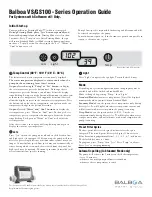
LP-551 Rev. 3.9.16
14
Part 4 - Piping
Failure to follow the instructions in this section WILL VOID the
warranty and may result in property damage, severe personal
injury, or death.
Dielectric unions or galvanized steel fittings must not be used
in a system with this boiler. Doing so WILL VOID the warranty.
Use only copper, brass, or stainless steel fittings. Teflon thread
sealant must be used on all connections.
DO NOT pipe this boiler with black iron, galvanized steel, steel,
or lead pipe. Doing so will result in premature product failure
and property damage, and WILL VOID the warranty.
A. General Plumbing Information
Use two wrenches when tightening water piping at boiler. Use
one wrench to prevent the boiler return or supply line from
turning. Failure to prevent piping connections from turning
could cause damage to boiler components.
The building piping system must meet or exceed the the piping
requirements in this manual.
NOTE:
The addition of a high temperature limiting device is
important if the boiler is to be connected to a domestic hot
water system.
Connect the cold water supply to both the storage bottom
port and the supply side of the boiler (shown in Applications,
this manual). It is important that you install a flow check on
the supply line of the boiler BEFORE connecting the feed line
to the storage tank. This allows the cold feed to flow through
the storage tank first. It is recommended that you install shut
off valves on the cold feed line for future ease of service. If there
is a back flow preventer or any type of no return valve in the
system, then you must install an additional tee for a suitable
potable hot water expansion tank. Connect the storage tank
return line to the return connection located on the boiler (shown
in Applications, this manual). Then connect the storage tank hot
water outlet to the hot water plumbing lines.
C. Backflow Preventer
Use a backflow preventer specifically designed for boiler
installations. This valve should be installed on the cold water
fill supply line per local codes.
D. Potable Expansion Tank
A potable hot water expansion tank is required to offset
heated water expansion. In most city plumbing systems, the
water meter has a no return or back flow device built into
the system to prevent back flowing of water into city mains.
B. Relief Valve
To avoid water damage or scalding due to relief valve operation:
•
Discharge line must be connected to relief valve outlet
and run to a safe place of disposal. Terminate the
discharge line in a manner that will prevent possibility of
severe burns or property damage should the relief valve
discharge.
Plumbing of this product should only be done by a qualified,
licensed plumber in accordance with all local plumbing codes.
The boiler is designed to be connected to a storage tank to
supply domestic hot water. HTP offers 60/80/119/175 gallon size
storage tanks in either stainless steel or glass-lined construction.
These storage tanks will be directly connected to the boiler
supply and return connection.
Connect discharge piping to a safe disposal location following
the guidelines below.
•
Discharge line must be as short as possible and
the same size as the valve discharge connection
throughout its entire length.
•
Discharge line must pitch downward from the valve
and terminate at least 6” above the floor drain, making
discharge clearly visible.
•
The discharge line shall terminate plain, not threaded,
with a material serviceable for temperatures of 375
o
F
or greater.
•
Do not pipe discharge to any location where freezing
could occur.
•
No valve may be installed between the relief valve and
boiler or in the discharge line. Do not plug or place any
obstruction in the discharge line.
•
Test the operation of the relief valve after filling and
pressurizing the system by lifting the lever. Make sure
the valve discharges freely. If the valve fails to operate
correctly, immediately replace with a new properly
rated relief valve.
•
Test T&P valve at least once annually to ensure the
waterway is clear. If valve does not operate, turn the
boiler “off” and call a plumber immediately.
•
Take care whenever operating relief valve to avoid
scalding injury or property damage.
FAILURE TO COMPLY WITH THE ABOVE GUIDELINES
COULD RESULT IN FAILURE OF RELIEF VALVE OPERATION,
RESULTING IN POSSIBILITY OF SUBSTANTIAL PROPERTY
DAMAGE, SEVERE PERSONAL INJURY, OR DEATH.
RE-INSPECTION OF T&P RELIEF VALVES: T&P valves
should be inspected AT LEAST ONCE EVERY THREE
YEARS, and replaced if necessary,
by a licensed plumbing
contractor or qualified service technician to ensure that the
product has not been affected by corrosive water conditions
and to ensure that the valve and discharge line have not been
altered or tampered with illegally. Certain naturally occuring
conditions may corrode the valve and its components over
time, rendering the valve inoperative. Such conditions can
only be detected if the valve and its components are physically
removed and inspected.
Do not attempt to conduct an
inspection on your own.
Contact your plumbing contractor
for a re-inspection to assure continued safety.
Do not thread a cap or plug into the relief valve or relief
valve line under any circumstances! Explosion and property
damage, serious injury, or death may result.
FAILURE TO RE-INSPECT THE T&P VALVE AS DIRECTED
COULD RESULT IN UNSAFE TEMPERATURE AND/OR
PRESSURE BUILD-UP WHICH CAN RESULT IN PROPERTY
DAMAGE, SERIOUS PERSONAL INJURY, OR DEATH.
Summary of Contents for EP-220 VWH
Page 33: ...LP 551 Rev 3 9 16 33 Figure 24 Cascade Master and FollowerWiring ...
Page 34: ...LP 551 Rev 3 9 16 34 Figure 25 Internal Connection Diagram ...
Page 57: ...LP 551 Rev 3 9 16 57 Figure 30 Combustion System Replacement Parts 220kBTU Model ...
Page 58: ...LP 551 Rev 3 9 16 58 Figure 31 Combustion System Replacement Parts 299 399kBTU Models ...
Page 59: ...LP 551 Rev 3 9 16 59 Figure 32 Replacement Parts All Models ...















































